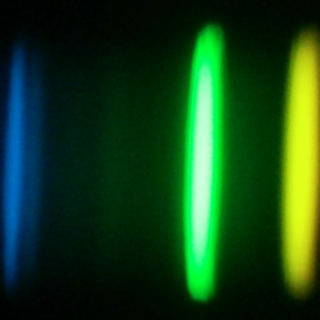Bibcode
Hobson, M. J.; Bouchy, F.; Lavie, B.; Lovis, C.; Adibekyan, V.; Allende Prieto, C.; Alibert, Y.; Barros, S. C. C.; Castro-González, A.; Cristiani, S.; D'Odorico, V.; Damasso, M.; Di Marcantonio, P.; Dumusque, X.; Ehrenreich, D.; Figueira, P.; Génova Santos, R.; Gilbert, E. A.; González Hernández, J. I.; Lillo-Box, J.; Lo Curto, G.; Martins, C. J. A. P.; Mehner, A.; Micela, G.; Molaro, P.; Nunes, N. J.; Palle, E.; Pepe, F.; Rebolo, R.; Rodrigues, J.; Santos, N.; Sousa, S. G.; Sozzetti, A.; Suárez Mascareño, A.; Tabernero, H. M.; Udry, S.; Zapatero Osorio, M. -R.; Armstrong, D. J.; Ciardi, D. R.; Collins, K. A.; Collins, K. I.; Everett, M.; Gandolfi, D.; Howell, S. B.; Jenkins, J. M.; Kielkopf, J.; Livingston, J. H.; Lund, M. B.; Mireles, I.; Ricker, G. R.; Schwarz, R. P.; Seager, S.; Tan, T. -G.; Ting, E. B.; Winn, J. N.
Referencia bibliográfica
Astronomy and Astrophysics
Fecha de publicación:
8
2024
Revista
Número de citas
9
Número de citas referidas
7
Descripción
Context. Since 2018, the ESPRESSO spectrograph at the VLT has been hunting for planets in the southern skies via the radial velocity (RV) method. One of its goals is to follow up on candidate planets from transit surveys such as the TESS mission, with a particular focus on small planets for which ESPRESSO's RV precision is vital.
Aims: We aim to confirm and characterise, in detail, three super-Earth candidate transiting planets from TESS using precise RVs from ESPRESSO.
Methods: We analysed photometry from TESS and ground-based facilities, high-resolution imaging, and RVs from ESPRESSO, HARPS, and HIRES, to confirm and characterise three new planets: TOI-260 b, transiting a late K dwarf, and TOI-286 b and c, orbiting an early K dwarf. We also updated the parameters for the known super-Earth TOI-134 b (L 168-9 b), which is hosted by an M dwarf.
Results: TOI-260 b has a 13.475853−0.000011+0.000013 d period, 4.23 ± 1.60 M⊕ mass, and 1.71 ± 0.08 R⊕ radius. For TOI-286 b we find a 4.5117244−0.0000027+0.0000031 d period, 4.53 ± 0.78 M⊕ mass, and 1.42 ± 0.10 R⊕ radius; for TOI-286 c, we find a 39.361826−0.000081+0.000070 d period, 3.72 ± 2.22 M⊕ mass, and 1.88 ± 0.12 R⊕ radius. For TOI-134 b we obtain a 1.40152604−0.00000082+0.00000074 d period, 4.07 ± 0.45 M⊕ mass, and 1.63 ± 0.14 R⊕ radius. Circular models are preferred for all the planets, although for TOI-260 b the eccentricity is not well constrained. We computed bulk densities and placed the planets in the context of composition models.
Conclusions: TOI-260 b lies within the radius valley, and is most likely a rocky planet. However, the uncertainty on the eccentricity and thus on the mass renders its composition hard to determine. TOI-286 b and c span the radius valley, with TOI-286 b lying below it and having a likely rocky composition, while TOI-286 c is within the valley, close to the upper border, and probably has a significant water fraction. With our updated parameters for TOI-134 b, we obtain a lower density than previous findings, giving a rocky or Earth-like composition.
Aims: We aim to confirm and characterise, in detail, three super-Earth candidate transiting planets from TESS using precise RVs from ESPRESSO.
Methods: We analysed photometry from TESS and ground-based facilities, high-resolution imaging, and RVs from ESPRESSO, HARPS, and HIRES, to confirm and characterise three new planets: TOI-260 b, transiting a late K dwarf, and TOI-286 b and c, orbiting an early K dwarf. We also updated the parameters for the known super-Earth TOI-134 b (L 168-9 b), which is hosted by an M dwarf.
Results: TOI-260 b has a 13.475853−0.000011+0.000013 d period, 4.23 ± 1.60 M⊕ mass, and 1.71 ± 0.08 R⊕ radius. For TOI-286 b we find a 4.5117244−0.0000027+0.0000031 d period, 4.53 ± 0.78 M⊕ mass, and 1.42 ± 0.10 R⊕ radius; for TOI-286 c, we find a 39.361826−0.000081+0.000070 d period, 3.72 ± 2.22 M⊕ mass, and 1.88 ± 0.12 R⊕ radius. For TOI-134 b we obtain a 1.40152604−0.00000082+0.00000074 d period, 4.07 ± 0.45 M⊕ mass, and 1.63 ± 0.14 R⊕ radius. Circular models are preferred for all the planets, although for TOI-260 b the eccentricity is not well constrained. We computed bulk densities and placed the planets in the context of composition models.
Conclusions: TOI-260 b lies within the radius valley, and is most likely a rocky planet. However, the uncertainty on the eccentricity and thus on the mass renders its composition hard to determine. TOI-286 b and c span the radius valley, with TOI-286 b lying below it and having a likely rocky composition, while TOI-286 c is within the valley, close to the upper border, and probably has a significant water fraction. With our updated parameters for TOI-134 b, we obtain a lower density than previous findings, giving a rocky or Earth-like composition.
Tables B.1-B.4 are available at the CDS via anonymous ftp to cdsarc.cds.unistra.fr (ftp://138.79.128.5) or via https://cdsarc.cds.unistra.fr/viz-bin/cat/J/A+A/688/A216
Proyectos relacionados

Estrellas de Baja Masa, Enanas Marrones y Planetas
Se investigan los procesos que conducen a la formación de estrellas de baja masa, enanas marrones y exoplanetas y caracterizar las propiedades físicas de estos astros en varias etapas evolutivas. Las estrellas de muy baja masa y las enanas marrones son probablemente los objetos más numerosos de nuestra Galaxia, pero no por ello están
Rafael
Rebolo López

Exoplanetas y Astrobiología
La búsqueda de vida en el Universo se ha visto impulsada por los recientes descubrimientos de planetas alrededor de otras estrellas (los llamados exoplanetas), convirtiéndose en uno de los campos más activos dentro de la Astrofísica moderna. En los últimos años los descubrimientos cada vez más numerosos de nuevos exoplanetas y los últimos avances
Enric
Pallé Bago

Abundancias Químicas en Estrellas
La espectroscopía de estrellas nos permite determinar las propiedades y composiciones químicas de las mismas. A partir de esta información para estrellas de diferente edad en la Vía Láctea es posible reconstruir la evolución química de la Galaxia, así como el origen de los elementos más pesados que el boro, forjados principalmente en los interiores
Carlos
Allende Prieto